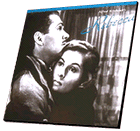

USA suspense
1940
bw 130 min.
Director: Alfred Hitchcock
CAV: $124.95 - available
3 discs, catalog # CC1198L
CLV: $69.95 - available
2 discs, catalog # CC1199L

As David O. Selznick put Gone
with the Wind into production in the late 1930s, he realized that he needed help with
other pictures on the studio schedule. He had soon hired a rotund Englishman as director
and producer, but Rebecca -- the first of four collaborations with Alfred
Hitchcock -- was very much a David O. Selznick production and a Selznick International
release. In Rebecca, the wealthy Maxim de Winter marries a plain, innocent
young woman, and takes her home to Manderley. There the devoted housekeeper Mrs. Danvers
keeps alive the memory of de Winter's first wife, Rebecca, who lent glamour and beauty to
her husband's ancestral home. Driven by anxiety over her own inadequacy and Danvers'
psychological terror, the heroine contemplates suicide -- until she learns the truth
about her predecessor.
"We bought [the novel] Rebecca and we intend to make
Rebecca," Selznick told Hitchcock early on, but the director had other ideas. "I
believe that I owe much of the success I have been lucky enough to achieve to my
'ruthlessness' in adapting stories for the screen," Hitchcock said. Though the initial
screen treatment of the novel bore Hitchcock's signature, Selnick argued for structure,
characterization, and dialogue much as author Daphne du Maurier had conceived them.
Producer and director battled for almost a year as the writers produced a well-crafted
screenplay, an amalgam of Selznick fidelity and Hitchcock touches.
On casting, Selznick
and Hitchcock were in closer agreement. Though they settled with relative speed on Judith
Anderson for Danvers and Laurence Olivier for de Winter, they tested well over
twenty-five actresses for the second Mrs. de Winter, including Olivier's lover, Vivien
Leigh. She has "a sincere and naive hopefulness," Hitchcock observed about Lucille
Fairbanks, Douglas' niece, but also "a husky voice reminiscent of Mae West in her youth
(if any) and I don't really think we can take her seriously." The director called
Marjorie Reynolds "too much gangster's moll," Jean Muir "too big and sugary," and Audrey
Reynolds "excellent for Rebecca who doesn't appear." Finalists Anne Baxter and Margaret
Sullavan lost their role to Joan Fontaine.
Hitchcock saw happiness as "a clear
horizon," but the Rebecca set in fall 1939 was far from happy. The members of the
British colony who dominated the cast shunned Fontaine, whose performance as the
vulnerable heroine may actually have been quickened by her fellow players' distance.
Selznick's appearance on the set always unnerved Hitchcock, and in fact the producer
supervised the shooting of several key scenes, including the housekeeper's reverential
tour through Rebecca's bedroom and the fire that turned Manderley to ruins. Even when
Selznick was not present, his "spies" -- those white-collar studio clerks and craftsmen
who worked under Hitchcock but for Selznick -- kept the director in check. Hitchcock
nonetheless lit and photographed the picture with enormous care; likewise, he was the
master of both suspense and psychological torment, nowhere better portrayed than in the
ambiguous relationship of Mrs. Danvers to Rebecca and even the heroine, Maxim de Winter's
second wife.
By Thanksgiving 1939, Hitchcock had shot nearly a quarter million feet of
exposed film. Selznick loved the freedom that miles and miles of footage offered him, and
in the small clapboard editing room at his Culver City studio, he reshaped the picture
that Hitchcock had shot. The producer avoided the "cutty" style of British Hitchcock, the
collision of images that generated thrills or suspense. Following conventional Hollywood
protocol, he tended toward long shots that fused character and setting or medium shots
that accommodated or privileged two or more actors engaged in dialogue. While Hitchcock
prized the visual, Selznick -- an inveterate memo writer -- prized the literary or
verbal.
Audience and critics found more than enough words to praise Rebecca.
Theatre Arts called the picture "a piece of suspenseful Hitchcock magic," and
Time devoted two of six paragraphs to an analysis of the director's beautifully
orchestrated "confession scene" where the heroine learns the truth about Rebecca. The
New York Times observed that while the American Hitchcock had become "less
individualized," he had also developed his "widely publicized 'touch' " into "a firm,
enveloping grasp."
Rebecca was a true collaboration, though. Hitchcock knew much
about screen language, about the power of the composition and the cut; under his
direction, cinematographer George Barnes avoided the excesses of German chiaroscuro yet
still evoked an artificial and oppressively stable world, utterly interior, utterly
appropriate to the fragile ego of the young bride. But Selznick helped bring luster,
seamless continuity, and narrative logic to Hitchcock's work. Likewise, Selznick's
editing smoothed the actors' performances but retained to great effect Hitchcock's
"cutty" shots of billowing curtains, monogrammed linens, sad dogs, and giant
doorknobs.
Throughout the picture -- molded by Hitchcock's direction and Selznick's
editing -- Olivier, Judith Anderson and especially Fontaine skirted the edge of Gothic
melodrama without ever losing their characters' humanity. The quintessence of the
Hollywood studio system, Rebecca advanced the careers of both its principal
creators.
-- LEONARD J. LEFF
Credits
Director: Alfred
Hitchcock
Screenplay: Robert E. Sherwood, Joan Harrison
Based on the novel by:
Daphne du Maurier
Adapted by: Philip MacDonald, Michael Hogan
Photographed by:
George Barnes
Music: Franz Waxman
Settings; Lyle Wheeler
Supervising Film
Editor: Hal V. Kern
Editor: James Newcom
Interiors Design: Joseph B.
Platt
Special Effects: Jack Cosgrove
A David O. Selznick
Presentation
Transfer
This edition of Rebecca was transferred from a
35mm fine grain composite master print. The sound was recorded from a 35mm optical
negative soundtrack.






